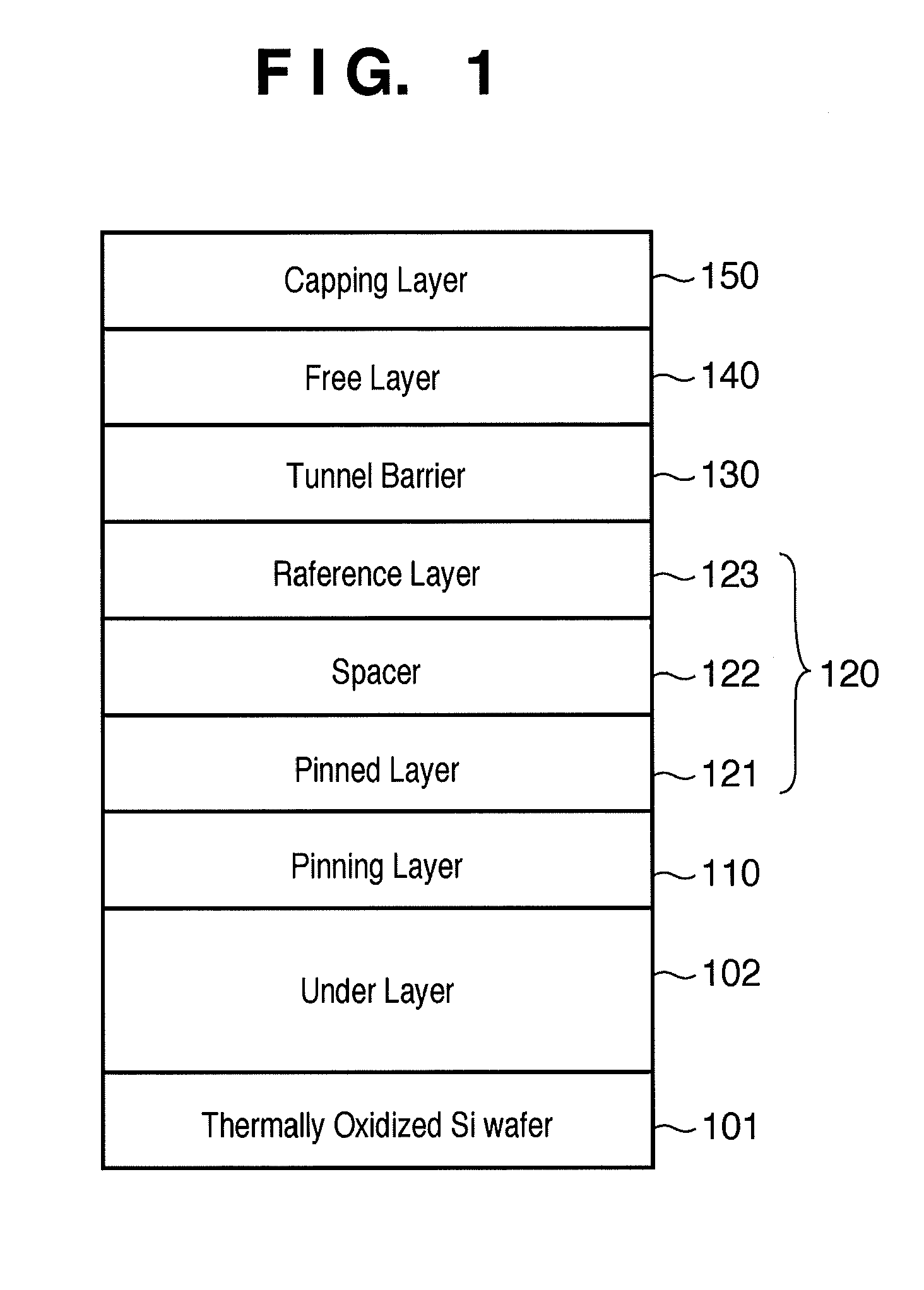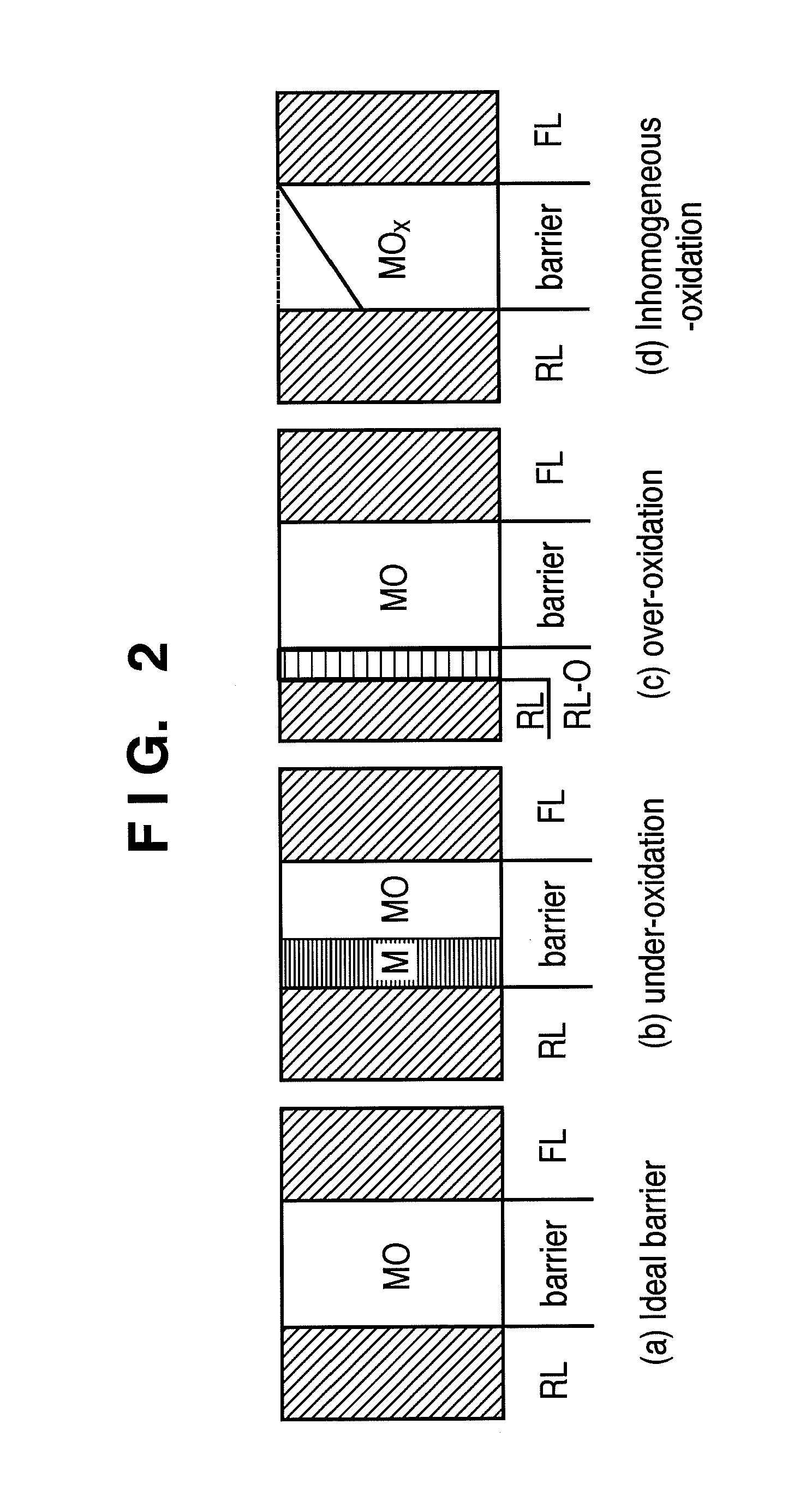Method of Manufacturing Magnetic Tunnel Junction Device and Apparatus for Manufacturing the Same
a technology of magnetic tunnel junction and manufacturing method, which is applied in the direction of nanoinformatics, magnetic bodies, instruments, etc., can solve the problems of reducing device performance and unable to obtain sufficient tunneling probability, and achieves excellent quality of manufactured products, high tmr ratio, and large ra product
- Summary
- Abstract
- Description
- Claims
- Application Information
AI Technical Summary
Benefits of technology
Problems solved by technology
Method used
Image
Examples
first embodiment
[0056]FIG. 1 shows a typical deposition structure of a tunnel resistance (TMR) sensor or memory element. A general MTJ includes a ferromagnetic pinning layer 110, synthetic antiferromagnetic pinned layer 120, tunnel barrier 130, and ferromagnetic free layer 140. In the deposition structure shown in FIG. 1, the synthetic antiferromagnetic pinned layer 120 includes a ferromagnetic pinned layer 121, nonmagnetic spacer 122, and ferromagnetic reference layer 123.
[0057]FIG. 9 exemplifies a MTJ device manufacturing apparatus and is a schematic plan view of a vacuum processing system for processing a magnetic tunnel junction device.
[0058]The vacuum processing system comprises a cluster type system having a plurality of deposition chambers 230, 240, and 250 capable of depositing thin films using the physical vapor deposition method. The plurality of deposition chambers 230, 240, and 250 are connected to a vacuum transport chamber 280 having robot loaders (not shown) at its center. Two load l...
second embodiment
[0089]The second embodiment will exemplify a MTJ tunnel barrier forming method of forming a tunnel barrier by inserting a very thin metallic Mg layer, forming an oxygen surfactant layer, performing radical oxidation at a low RF power, and depositing a metallic Mg cap layer.
[0090]As shown in FIG. 5B, an MgO barrier according to the present invention is formed as follows. A first metallic Mg layer 131 is deposited on a CoFeB ferromagnetic reference layer 123 to a two-atomic layer thickness (0.43 nm). The first metallic Mg layer is exposed to an oxygen atmosphere of 1.17×10−2 Pa·sec (90 Langmuir) to form a first oxygen surfactant layer 132. A second metallic Mg layer 133′ is deposited on the first oxygen surfactant layer 132 to a two-atomic layer thickness (0.43 nm). The second metallic Mg layer 133′ is exposed to an oxygen atmosphere of 1.17×10−2 Pa·sec (90 Langmuir) to form a second oxygen surfactant layer 135. A third metallic Mg layer 136 is deposited on the second oxygen surfactan...
PUM
| Property | Measurement | Unit |
|---|---|---|
| thickness | aaaaa | aaaaa |
| temperature | aaaaa | aaaaa |
| power | aaaaa | aaaaa |
Abstract
Description
Claims
Application Information
 Login to View More
Login to View More - R&D
- Intellectual Property
- Life Sciences
- Materials
- Tech Scout
- Unparalleled Data Quality
- Higher Quality Content
- 60% Fewer Hallucinations
Browse by: Latest US Patents, China's latest patents, Technical Efficacy Thesaurus, Application Domain, Technology Topic, Popular Technical Reports.
© 2025 PatSnap. All rights reserved.Legal|Privacy policy|Modern Slavery Act Transparency Statement|Sitemap|About US| Contact US: help@patsnap.com



